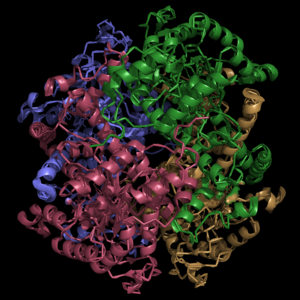Sandbox Reserved 1058
From Proteopedia
| Line 7: | Line 7: | ||
Isocitrate lyase plays a key role in survival of ''M. tuberculosis'' by sustaining intracellular infections in inflammatory respiratory macrophages. Used in the citric acid cycle, isocitrate lyase is the first enzyme catalyzing the carbon conserving glyoxylate pathway. This glyoxylate pathway has not been observed in mammals and thus presents a unique drug target to solely attack TB infections. | Isocitrate lyase plays a key role in survival of ''M. tuberculosis'' by sustaining intracellular infections in inflammatory respiratory macrophages. Used in the citric acid cycle, isocitrate lyase is the first enzyme catalyzing the carbon conserving glyoxylate pathway. This glyoxylate pathway has not been observed in mammals and thus presents a unique drug target to solely attack TB infections. | ||
| - | + | ==Protein Structure== | |
| - | == | + | ===Crystal Structure=== |
| - | === | + | [[Image:Normal_Crystal_Structure.png|300 px|center|thumb|Figure Legend]] |
| - | + | ||
<StructureSection load='1F8I' size='340' side='right' caption='Isocitrate Lyase' scene='> | <StructureSection load='1F8I' size='340' side='right' caption='Isocitrate Lyase' scene='> | ||
| - | This is a default text for your page '''Perry Rabin/Sandbox 1'''. Click above on '''edit this page''' to modify. Be careful with the < and > signs. | ||
| - | You may include any references to papers as in: the use of JSmol in Proteopedia <ref>DOI 10.1002/ijch.201300024</ref> or to the article describing Jmol <ref>PMID:21638687</ref> to the rescue. | ||
| - | |||
| - | == Structure == | ||
| - | [[Image:Normal_Crystal_Structure.png|300 px|center|thumb|Figure Legend]] | ||
== Function == | == Function == | ||
| - | |||
| - | == Disease == | ||
== Structural highlights == | == Structural highlights == | ||
Revision as of 17:33, 27 March 2015
Contents |
Isocitrate Lyase from Mycobacterium tuberculosis
Relevance
Background
Mycobacterium tuberculosis is a respiratory infection that causes numerous fatalities throughout the world. It lives in organisms and feeds off of host cells, which indicate a variety of lipases exist within M. tuberculosis. Current drugs that are on the market now target a small number of bacterial processes like cell wall formation and chromosomal replication. Although several antibiotics exist, all of them target these same mechanisms of inhibition. These commonalities have led to the prevalence of different multi-drug resistant (MDR) tuberculosis strains. Due to the high level of resistance, finding a lasting treatment for MDR TB infections has become very problematic. Studies into new mechanisms of inhibition will be crucial to prevent widespread outbreaks.
Clinical Implications
Isocitrate lyase plays a key role in survival of M. tuberculosis by sustaining intracellular infections in inflammatory respiratory macrophages. Used in the citric acid cycle, isocitrate lyase is the first enzyme catalyzing the carbon conserving glyoxylate pathway. This glyoxylate pathway has not been observed in mammals and thus presents a unique drug target to solely attack TB infections.
Protein Structure
Crystal Structure
| |||||||||||

